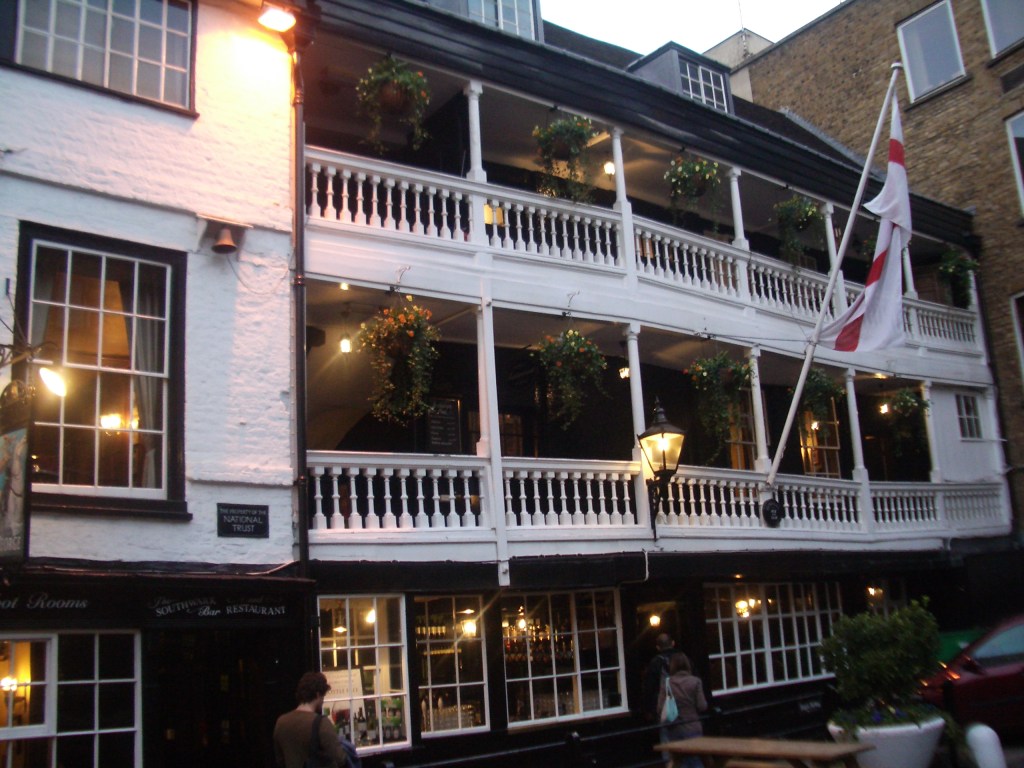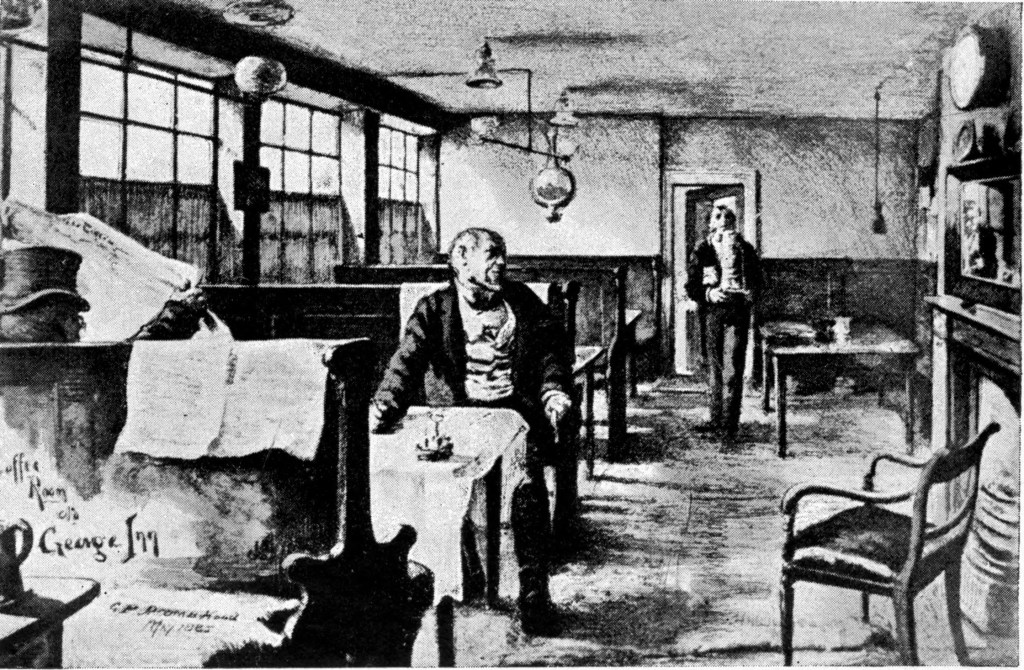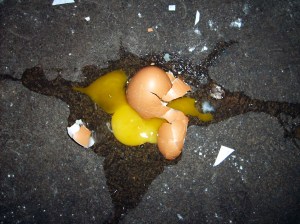
The George Inn, Southwark. The only galleried coaching inn left in London.
Photographer: User:Justinc Attribution: CC BY-SA 2.0,
When a Folkestone baker fell foul of a confidence trickster it was not so much a case of the wrong trousers as the missing ones! But what really happened … and who was telling the truth?
Fascinating, dangerous and dirty, 18th century Southwark was Kent’s gateway to London. The trial of Mary Smith offers an insight into a bustling commercial hub that was also a refuge for thieves, fraudsters and highwaymen, revealing the kind of trap that awaited unwitting ‘countrymen’ such as Folkestone baker William Hutchins.
When William visited Southwark in 1781, he could not have foreseen the unfortunate consequences of his trip. After many uncomfortable hours either in the saddle or bouncing over potholes in a badly-sprung carriage, he probably alighted at one of the twenty-three coaching inns in Borough High Street. He may then have taken a draft of ale at The George Inn which still survives, much as William would have seen it, with its unique first-floor gallery.

The George Inn, Southwark, 1889 Public domain
The reason for William’s visit to London is uncertain. Perhaps he had come up on business, intending to sell his wares in Borough market or to visit one of the corn-factors who operated from the collection of buildings known as Bridge House. He might even have been looking for work. However, while business may have been his primary motive, he also appears to have made time for some carousing in the local ale-houses. By the time he ran – literally – into Mary Smith, he had been in Southwark for several hours and was somewhat the worse for wear.
“About eight at night, I was coming out of a cook’s shop, and ran full-but against this woman,” William recalls.
There followed a brief exchange in which William claimed to know the woman and in which she subsequently offered to put him up in her room. William accepted, claiming that he went to sleep almost immediately. Later, when questioned if he had been “in liquor”, he made a partial admission: “Not so much in liquor but I knew what I did.”
The rest is farce. William awoke next day to find that he had been relieved of his breeches, coat, waistcoat, stockings, neck-cloth and handkerchief as well as fifteen shillings. He had been left only his shoes, buckles, shirt, hat and a second pair of stockings “tied up in a twist” that had been accidentally dropped by the thief.
In an embarrassing state of undress, William was about to send for new apparel, when an old woman appeared at the lodging carrying his lost garments. With unusual generosity, Mary Smith’s boyfriend and partner-in-crime had sent the clothes back. His reason?
“D— it! I don’t mind robbing a man, but you don’t leave him stark naked.”
Initially, when the local justice caught up with Mary, she admitted pawning the stockings and neck-cloth in The Strand. However, by the time the case came to trial at the Old Bailey, she had changed her story, claiming that William had claimed to know her from Maidstone – a connection that she denied – and had followed her home. In order to get rid of him, she had thrown his clothes out of the window.
By now, William had become a reluctant witness, claiming that he would have been willing to drop the case had he only been able to get his neck-cloth and stockings back. (Oddly, he made no mention of the breeches!) However, faced with a £40 fine if he failed to prosecute, William had no choice.

The Coffee Room at The George Inn By George Percy Jacomb-Hood. Public domain.
Still insisting that he had known Mary previously, William seemed almost desperate to excuse her. He suggested that the neck-cloth and stockings might have been dropped by the old woman who returned his clothes “in a confused manner” and that the old woman might even have taken his 15s.
However, when asked if he had been sufficiently sober to identify Mary as the woman who had been in the bed-room with him, William’s gallantry suddenly deserted him. His reply?
“Yes; but she looked better by candle-light than she does now by daylight.”
Convinced of Mary’s guilt, the judge added injury to William’s insult, sentencing her to a whipping and three months in prison.
Did either of the protagonists learn their lesson? Did William, chastened by his experience, ever return to London? And did Mary, the aspiring seductress and thief, become an honest woman? Sadly, the records are silent.
Postscript: While there is no evidence that William visited The George, the images above illustrate the type of coaching inn that was commonplace in contemporary Southwark.
Sources:
The Trial of Mary Smith from Proceedings of the Old Bailey Online
John Noorthouck’s A New History of London (publd. 1773): ‘Book 3, Ch. 1: Southwark‘ (at British History Online)
‘Borough High Street’, Survey of London: volume 22: Bankside (the parishes of St. Saviour and Christchurch Southwark) (1950), pp. 9-30 (at British History Online).










10 Tips for Survival in the Swimming Pool
Learning to swim 1939
Anyone who has considered taking up swimming for purposes of relaxation should forget it. In my opinion, swimming in a communal pool carries a level of stress equivalent to that of a fighter-pilot in battle mode. Forget those banal signs about ‘not diving off the side’ etc. These are the real rules of pool etiquette:
When someone politely suggests that your five-year old should not be launching himself off the side into – or rather on top of – oncoming swimmers, do not spring to his defence by leaping into the water and attacking that individual. Yup! Happened to me.
I just happened to look askance at said child who narrowly missed landing on my head and dad was in the water pronto to land a crippling kick on my shins. May the powers of darkness rot his budgie smugglers!
Do keep your nails long – preferably filed to a sharp point – for purposes of self-defence and meting out justice to any miscreants like those described above.
Watch out for anyone who casually drapes their bath-robe over the chair where you’ve left your towel/shampoo. Chances are your belongings won’t be there when you get back. (That’s happened to me, too!)
No-one objects to you clocking up your lengths, but don’t be a pool-hog. Swimming over any object that gets in your way – usually another, slower swimmer – is not acceptable behaviour.
Please, please don’t swim in pairs for a leisurely chat. It’s a huge obstacle to other swimmers who usually collide in their attempts to get round you.
Even worse, don’t hang around the end of the pool having a lengthy conference with your mates. It’s really irritating for anyone trying to complete their lengths and who, like me, has an irresistible desire to touch the end just to prove they’ve done it!
Don’t pick up your children by the ankles, swing them around your head and then let go to see how far they travel. This is a swimming-pool not the highland games!
If you’ve never done it before, don’t try to hoist yourself out of the pool. While Olympic athletes may exit with one effortless leap, you are more likely to get stuck mid-way; less Tom Daley, more wallowing hippo. Play it safe. Use the steps.
Beware of anyone who suggests installing ‘lanes’ in your favourite pool because “this is how it was done at my old swimming-club”. Note the word ‘old’. Chances are that person was ejected from their former swimming-club for possessing a high irritation factor. Most casual swimmers are sensible enough to manoeuvre around each other without the need for unnecessary nannying.
If aqua-aerobics begins at 8.30 – and you are not a participant – make sure you leave the pool at 8.20. Otherwise, you risk being swamped by an avalanche of foam objects being chucked into the water and a herd of exercise fanatics who always arrive early to stake their claim.
It may feel a bit unfair to be cheated of an extra 10 minutes but it’s worth it to avoid the shoal of floundering bodies and the assault on your ears from the instructor’s tinny CD player. If, against all reason, you find yourself jigging along to the rhythm, just repeat this mantra: “I came here to swim, not to be cheerful. I hate this pool and everyone in it!”
It always works for me!